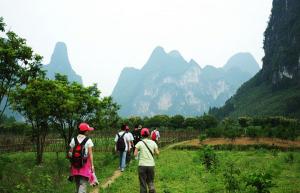Top Ancient Towns & Villages in China
China is filled with incredible ancient towns and villages and a visit to one of them during a China Tour is a great way to experience the history of China first hand and give visitors a look into the lives of the local people as they have been for centuries. Each village has its own unique design, architecture, and culture. A visit to China’s ancient towns and villages is an unforgettable experience.
Shanghai
Zhujiajiao Ancient Town:
Located in the suburbs of Shanghai, Zhujiajiao Ancient Town is famous throughout China and has a history of over 1,700 years. Zhujiajiao Ancient Town is a fan shaped town which has been remarkably well preserved and retains its ancient features. A water town, Zhujiajiao has as many canals as it has streets and because of this the town has dozens of ancient bridges made of stone and wood. Taking a water taxi down the town’s canals is a great way to enjoy this fascinating place. The town is home to several ancient gardens which are open to visitors. Their combination of beautiful architecture, paths and rockeries, and flora make them unforgettable.
Xitang
Strolling the ancient water town of Xitang feels like a stepping into a traditional Chinese painting. This beautiful village features ancient bridges, stunning architecture, and calm tree lined canals. The town’s covered corridor is its most famous feature and makes it unique among water towns. The corridor is more than 1,000meters long and was built to allow people to stroll through the town out of the weather. The narrow lanes and alleys of Xitang are another fascinating features of the town. They are the main thoroughfares of the town and many of them are so narrow only one person at a time can walk along them.
Wuzhen
Located in Zhejiang Province, Wuzhen is one of the most famous water towns in China. The town is beautifully preserved and is unique in that it is divided into six distinct districts: the Traditional Workshops district, Traditional Cultural District, Traditional Food and Beverage District, Traditional Shops and Stores District, Traditional Residential District, and the Traditional Water Town Life District. Each district is unique and gives visitors are real insight into the workings of this ancient town. Of note is the Fanglu Pavilion. It is a famous teahouse and was named after Luyu, the patron saint of Tea.
Luzhi
With a history of more than 1,400 years, Luzhi is located east of Suzhou city. It is an extremely beautiful water town with a history of more than 1,400 years. Luzhi is known for its temples notably the Baosheng Temple and the White Lotus Flower Temple. The Baosheng Temple was built more than 1,500 years ago and its clay arhats, which were crafted during the Tang Dynasty (618-907) are well preserved. The Xiao Mansion, built during the Qing Dynasty represents a typical mansion of the area. It is has been beautifully maintained and offers a good insight into what life was like for the elite of the Qing Dynasty.
Tongli Ancient Town Tongli Ancient Town
Mudu Ancient Town Mudu Ancient Town
Tongli
Perhaps one of the most beautiful water towns in China, Tongli has a long history. Located near Suzhou, this water town is filled with mansions and private gardens which are open to the public. The town is still alive with locals living as they have for centuries and a visit here really makes visitors feel like they are visiting real China. The town’s many gardens are stunning and because they are not as famous as the gardens in Suzhou, are must less busy. They are an exceptional way to see what it would have been like to visit a family garden when they were new.
Mudu
Located south of Suzhou, Mudu is an ancient water town surrounded by hills. Mudu is known for its natural scenery and beauty. The town is filled with incredible architecture and has a lot of ancient private gardens. Located near the town is Lingyan Mountain, and Tianping Mountain. Both mountains are dotted with pavilions, temples, and spectacular rock formations. Mudu awaits visitors with a charm all its own.
Yunnan:
Lijiang
One of the most popular destinations in Yunnan Province, Lijiang is an ancient town inhabited by the Naxi Dongba Ethnic Minority Group. The town is in a remarkable state of preservation and is considered to be the best preserved ancient town in China. The town is very unique because of the culture of the Naxi Dongba people which permeates the architecture and culture of the town. The inhabitants of the town live as they always have and their unique culture is extremely colorful and visitors are always mesmerized by it.
Dali
Surrounded by mountains and home to 25 Ethnic Minority Groups, Dali is an incredible ancient city. Founded over 4,000 years ago by the Bai Ethnic Minority Group, the city grew and as more Ethnic Groups arrived, its culture and design changed. The city’s ancient buildings, city walls and moat add to the appeal of this beautiful city. Located outside the city are Dali’s Three Pagodas, the only pagodas built in a set of three in China. Their design is unique and overlooks a scene of great natural beauty.
Shuhe Ancient Town Shuhe Ancient Town
Pingyao Ancient City Pingyao Ancient City
Shuhe Ancient Town
Located 4 kilometers northwest of Lijiang, the ancient village of Shuhe lies hidden in a forest at the foot of the Jade Dragon Snow Mountain. It was located along the ancient Tea Horse Trail. The village is small in size, but it makes up for it in beauty.
Shanxi Province:
Pingyao
Pingyao is located in central Shanxi Province. The ancient city was home to some of the richest businessmen in China. Some of these men were richer than the emperor himself. The ancient city is famous for many reasons. The city was home to China’s first bank and the buildings have been beautifully preserved and allow visitors to see ancient banking practices. Located outside the city is the Qiao Mansion. The mansion was home to one of the richest families in China and it is truly an incredible place. Covering a huge area, the mansion has dozens of courtyards and every inch of the buildings are decorated with intricate carvings.
Hunan Province:
Fenghuang
The name “Fenghuang”, means Phoenix because according to legend, two phoenixes landed in the area and were so captivated by its beauty that they decided not to leave. The town is surrounded by mountains and is split by the Tuo Jiang River. The architecture of the town is unique and many of the buildings along the river are built overhanging the river. The town is dotted with mansions, gardens, and temples, and is considered one of the most beautiful towns in China.
Chongqing:
Ci Qi Kou (Porcelain Village)
The ancient town of Ci Qi Kou was famous as a porcelain manufacturing center during the Ming (1368-1644) and Qing (1644-1911) Dynasties. The town’s architecture date back to the Ming and Qing Dynasties and include many tea houses, studios and embroidery workshops. The town has a charm all its own with its grey brick houses with red doors lit by traditional lanterns.
Huangshan:
Xidi
With a history of over 900 years, Xidi Village is famed as a museum of Ming and Qing Dynasty architecture. The town is filled with ancestral halls, pavilions, gardens, and ancient mansions. The carvings on the brick, wood and stone of the residents are outstanding and display a level of craftsmanship not seen today. The village truly has the feeling of a living working village. The residents go about their lives as they always have. Xidi is surrounded by hills, and streams.
Hongcun
The village of Hongcun is was built in the shape of an ox by a famous Fengshui expert. In the center of the village is a crescent shaped pond which beautifully reflects the surrounding architecture like a mirror. The village is very quaint and has a beautiful charm to it. The village has many ancestral halls, ancient schools, and virtually every lane has its own canal with flowing water to supply every house. The architecture of some of the mansions and ancestral halls in Hongcun are incredible and it is said that Chengzhi Hall was gilded with 5 kilos of gold. It’s interior is covered with stunning carvings and paintings.
Guangxi:
Longsheng
Located outside of Guilin City, Longsheng is an incredible destination. Famous for its Rice Terraces, Longsheng has much more to offer. In China’s ancient past, the Zhuang, Yao, Miao, and Dong Ethnic Minority Groups were forced up into the mountains. Being agricultural societies, they had to find a way to continue farming and they did so in a very ingenious way. They turned the entire mountain range into rice fields by building terraces. The rice fields are incredible feats of engineering and are as beautiful as they are ingenious. The four Ethnic Minority Groups learned to live together, which caused a unique combining of their different cultures and traditions.

.jpg) China Heritage & Culture Tours
China Heritage & Culture Tours  China Train Tours
China Train Tours China Hiking & Trekking Tours
China Hiking & Trekking Tours 

